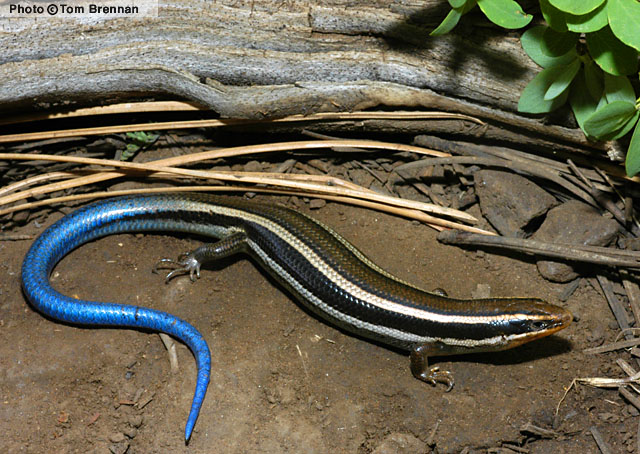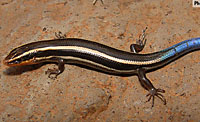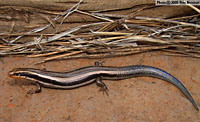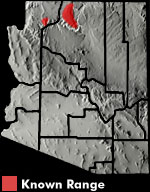Online Field Guide to The Reptiles and Amphibians of Arizona



Adult. Mohave County, AZ
 Juvenile. Mohave Co., AZ |
| WESTERN SKINK Plestiodon skiltonianus | |
|
DESCRIPTION: A small (up to 86 mm or 3.4″ from snout to vent), shiny lizard with a thick tail, a stout body, and small limbs. The neck is thick and the head is small. Coloration is dark brown to reddish brown. A cream colored stripe runs down each side of the back extending from the snout, over the eye, and to the base of the tail. An additional stripe runs along each lower side extending from the lip to the base of the tail. The tail is dull gray or blue-gray. The chin and sides of the face are often tinted orange-red during breeding season. Young are darker, have more distinct stripes, and have a bright blue tail. The scales are large, rounded, smooth, and very shiny. The similar looking Many-lined Skink has more numerous and varied stripes and a much longer tail (when not regenerated). HABITAT: In Arizona this lizard is found in Great Basin Conifer Woodland, Petran Montane Conifer Forest, and Petran Subalpine Conifer Forest communities. It inhabits rocky canyons, steep slopes, and foothills. It is most frequently found under rocks, logs, and other surface cover. BEHAVIOR: This ground-dweller is active during the day but most activity occurs under surface cover. When spotted it can be quite difficult to capture as it quickly slides and zigzags through the rocks or surface cover. It is capable of casting off (and regenerating) the tail. Pursuers and predators often end up with nothing but a wiggling tail. DIET: The Western Skink feeds on a variety of insects and spiders. REPRODUCTION: Eggs are laid in summer in a nest buried in moist soil. Clutch size ranges from 2 to 10 eggs. The female remains in the nest with the eggs to guard them. By Thomas C. Brennan Brennan, T. C., & A. T. Holycross. 2006. A Field Guide to Amphibians and Reptiles in Arizona. Arizona Game and Fish Department. Phoenix, AZ Stebbins, R.C. 2003. A Field Guide to Western Reptiles and Amphibians, Third Edition. Houghton Mifflin Company, Boston, MA. |
|
Visit Partners in Amphibian and Reptile Conservation:


HOME
Copyright © 2023, Arizona Game and Fish Department. All rights reserved.
If you make use of the textual contents of this site in reports, publications, etc. please cite and credit the author(s) and photographer(s). All photos on this website are copyrighted. However, those found in the species account section may be used for any noncommercial scientific, educational, or conservation purposes provided that photographs are not altered and continue to bear the copyright symbol and name of the photographer. Please contact the photographer regarding commercial use of copyrighted photographs.











